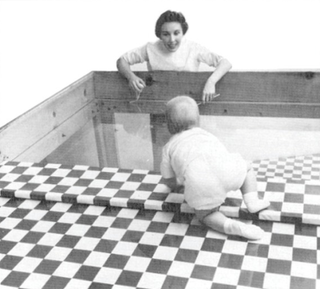Fear
Can Touch Help Us Overcome Fear?
A VR experiment suggests that focusing on touch can help soothe anxiety.
Posted November 5, 2022 Reviewed by Devon Frye
Key points
- Humans tend to prioritize visual input over input from our other senses, often to our detriment.
- A student VR experiment suggests that to overcome fear, it can help to focus on something comforting, like a close other's touch.
- If what you're seeing in the media makes you anxious, it could help to focus instead on what you can physically feel, right now.
In the pursuit of new ways to motivate my students and get them to really embrace our topics, I purchased a virtual reality headset and brought it to class. Slides and lectures are fine, I guess (if you don’t care much about student engagement), but there’s nothing quite like watching your students squeal with delight to help a teacher feel like his lesson is getting through.

Walking the Plank
I teach psychology, so the incredibly real sense of phobia you get from a 3D plank-walking app seems just the ticket. The app I found lets the wearer feel just like he or she is at the top of a skyscraper, staring down. Better than that, it has options that tempt them to walk out onto a plank suspended hundreds of feet up in the air—and step off if they dare. The plank creaks with each step and the feedback is designed to scare them back into the relative safety of an elevator.
It's funny to watch them balance precariously on an invisible thing, as though they’re terrified of falling off the floor of our classroom. You see, they know that the simulated altitude isn’t real. They know there is a solid floor beneath (and all around) them. They can even hear their classmates telling them it's going to be OK.
But the facts don’t matter. Their thoughts don't help. The headset just keeps whispering: "Careful! We're gonna fall!" No matter how brave they predict they will be, each student takes turns learning how much stronger this illusion is than those predictions.
The Visual Cliff
Is this new? Not really. Long ago there was a study done on infants using nothing more than a plate of glass and an illusion of depth (Gibson & Walk, 1960). Oddly enough, more age and more intellect are not a big advantage when it comes to the fear of heights. Contrary to what you might expect, we have less fear when we are born than when we grow up (and learn what to fear). We seem to acquire this peculiar phobia as we acquire the ability to crawl (around 7-9 months).

Now, this wouldn’t make for a very good psychological experiment if all I did was see if they were afraid of heights. No—I wanted to see if we could reduce or dispel this terrifying feeling using one of their other senses (therapeutic touch, for instance). We humans place way too much emphasis on visual processing, and not nearly enough on our sense of touch. We call that haptic processing in psychology.
Non-human animals still rely on touch more than we do, especially when in need of comfort (Harlow, 1958). We, on the other hand, have become sort of haphephobic as a species (afraid of being touched) and rely way too much on facts. I thought to myself: Maybe the touch of an invisible hand on an ankle or shoulder would be enough to overcome the powerful illusion of depth entering their eyes and ears.
Angels on the Plank
That’s what we did. I instructed another student to grasp the ankle or shoulder of the student wearing the headset. The result was instantaneous. Each headset wearer expressed a sense of invisible comfort (despite the continuing visual and auditory feedback from the virtual reality headset).
And if they closed their eyes—or peeked out from under the headset—the illusion of imminent danger vanished and that eerie, comforting, phantom hand reigned over their fear of falling. At one point, we even stood on either side of the plank-walker and took her by the hand, escorting her out onto the very edge of the plank. It was as though she were being upheld by an invisible angel on either side of her.
A Lesson in Comfort
What did we take away from this? Well, we learned that paying greater attention to your sense of touch than to your eyes and ears can decrease your fear—it reminds you of how safe you really are. So, if your feet keep telling you "yes, there is a floor here" but your brain keeps telling you to ignore your feet, maybe it’s time to listen to your feet more often.
But how does this apply to me, you ask? Well, we watch a lot of news these days, right? An illusion of awful things happening to somebody else bombards our eyes and ears every day—even though you and I are perfectly safe. To attract viewers, the media necessarily tries to make its viewers feel as if they are in imminent danger. Take, for example, all the stress over the midterm elections, and worries about the war in Ukraine (Kammer et al., 2022).
Watching the news each day seems to reinforce viewer malaise, and even generates a kind of future phobia (anticipatory anxiety). To mediate that, maybe if we concentrate on what our physical self is actually touching (instead of what our mental self is watching on TV), we can overcome some of that mental anxiety. Maybe, like my students and I did with the VR app, we can overcome the illusion that we are going to fall off the couch. Look away—and suddenly, things aren't as bad as they appear.
My humble advice? Change the channel by closing your eyes and focusing on the person beside you. Somewhere in the darkness, there's an angel of sensation, reminding you that everything is already OK.
References
Baum-Baicker, C. (2022). How to cope with midterm election stress. Psychology Today. Retrieved from https://www.psychologytoday.com/us/blog/clinical-wisdom-new-world/20221…
Gibson, E. J., & Walk, R. D. (1960). The "visual cliff." Scientific American, 202(4), 64–71. https://doi.org/10.1038/scientificamerican0460-64 64-71.
Harlow, H. F. (1958). The nature of love. American Psychologist, 13(12), 673.
Kammer, A., Azour, J., Selassie, A.A., Goldfajn, I., Rhee, C. (2022, March 15). How war in Ukraine Is reverberating across world’s regions. International Monetary Fund. Retrieved from https://www.imf.org/en/Blogs/Articles/2022/03/15/blog-how-war-in-ukrain…




